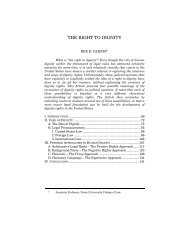A Right to Media? Lorie M. Graham - Columbia Law School
A Right to Media? Lorie M. Graham - Columbia Law School
A Right to Media? Lorie M. Graham - Columbia Law School
You also want an ePaper? Increase the reach of your titles
YUMPU automatically turns print PDFs into web optimized ePapers that Google loves.
480 COLUMBIA HUMAN RIGHTS LAW REVIEW [41:429<br />
boundaries.” 197 However, even with these programs, reliable funding<br />
still remains the greatest obstacle <strong>to</strong> the survival of Native American<br />
media.<br />
Moreover, public and private funding remains inconsistent<br />
and insufficient for increased production and distribution. Many<br />
indigenous media outlets are dependent on limited federal funds,<br />
because they lack commercial viability due <strong>to</strong> limited advertising<br />
revenue and a relatively small audience base. Moreover, the<br />
application of free market principles <strong>to</strong> media places the United<br />
States behind some other countries in regard <strong>to</strong> the development of<br />
indigenous television and other media networks.<br />
For instance, unlike Australia, the United States does not<br />
have a large, nationalized broadcaster. Rather, television networks in<br />
the United States are dependent on advertising dollars and,<br />
therefore, programming is driven more by ratings than by content.<br />
Because Native Americans as a whole make up a relatively small<br />
percentage of the population, however, it is difficult <strong>to</strong> make the case<br />
<strong>to</strong> profit-driven networks that it is in the interest of their bot<strong>to</strong>m<br />
lines <strong>to</strong> air Native American programming. This lack of indigenous<br />
control over production and distribution capabilities is a stubborn<br />
obstacle <strong>to</strong> the growth of Native American media.<br />
Further, while a myriad of Native American radio stations,<br />
print media, and television programming is being produced by Native<br />
Americans, these media sources are rarely consumed by nonindigenous<br />
peoples. Compounding the problem is the fact that<br />
mainstream private media outlets do not adequately cover the<br />
diversity of complex issues involving Native Americans. 198 The Native<br />
American Journalists Association (NAJA) conducted an extensive<br />
research project <strong>to</strong> examine the coverage of Native Americans in<br />
several of the most popular newspapers in the United States. A<br />
“content analysis of nine of America’s largest circulation newspapers”<br />
from 1999 through 2001 found “1,133 articles dealing with Native<br />
197. Press Release, Corporation for Public Broadcasting, CPB Awards $1.5<br />
Million <strong>to</strong> Help Establish Center for Native American Radio, Sept. 23, 2004,<br />
http://www.cpb.org/pressroom/release.php?prn=378.<br />
198. Kara Briggs, Tom Arviso, Dennis McAuliffe & Lori Edmo-Suppah,<br />
Native Am. Journalists Ass’n & News Watch, The Reading Red Report: Native<br />
Americans in the News: A 2002 Report and Content Analysis on Coverage by the<br />
Largest Newspapers in the United States III (2002) (“Our concern is based on a<br />
number of observations including a lack of coverage, uninformed coverage that<br />
perpetuates stereotypes and false perceptions, and gross inaccuracies.”).















